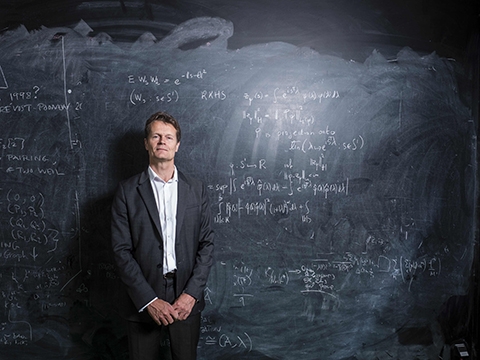
Spinoza Prize for Leiden statistician Aad van der Vaart
Aad van der Vaart, professor of stochastics at Leiden University, has been awarded the NWO Spinoza Prize for his groundbreaking research in statistics. Van der Vaart conducts fundamental research on models that can help, for instance, to identify genes that play a role in cancer.
Laudation of Aad van der Vaart

NWO announced the Spinoza laureates during the Bessensap scientific event in The Hague on 12 June. The other three laureates are Prof. René Janssen, professor of molecular materials and nanosystems at Eindhoven University of Technology, Prof. Birgit Meyer, professor of religious studies at Utrecht University, and Prof. Cisca Wijmenga, professor of human genetics at the University of Groningen.
Aad van der Vaart (1959) deserves this most prestigious scientific prize in the Netherlands because he is an international leading authority in the research field of mathematical statistics, says the NWO in its laudation. His books on estimation theories are highly influential works, while his applied statistics make an important contribution to areas such as medical imaging and statistical genetics. Fifteen years ago, he drew wide attention in the Netherlands to nonparametric Bayesian statistics, and it is partly thanks to his efforts that this branch of statistics has now developed into a key research field, continues the laudation
How do you feel about being awarded this prize?
‘It’s wonderful, of course, to receive this prize. I see it as a prize for my career over the last twenty-five years, and not just one specific aspect of that. But certainly one of the most important areas is my research on infinite dimensional Bayesian statistics. The prize will help to give statistics a stronger position in the Netherlands.’
What does Bayesian statistics involve?
‘Bayesian statistics is one of the two paradigms in statistics. It starts out from a so-called ‘prior distribution’, which expresses in probabilities what you already know about a certain situation. For example, that only a small number of genes are active, and perhaps the genes from a certain network are more likely to be active than others. New information and measurements are incorporated by updating this prior distribution. It seems very logical, but what’s new is that we’re now applying this principle - Bayes’ rule - to highly complex models and with vast amounts of data. The prior distribution is then a complex object. This makes it possible to add a lot of relevant information to the analysis, but it could also mean that the end result of the analysis is determined by the assumptions and not the data. That is the traditional objection to the Bayesian method.’
What contribution have you made to innovation within this field?
‘Before 2000 it was thought that this negative aspect was too strong. Together with others, I have shown that this is not so, provided the methods are used correctly. Our mathematical analyses reveal how the properties of the prior distributions affect the end result.’
How do you apply this kind of statistics?
‘An important application is in modern genetics. Medical researchers are now able, for instance, to read an entire genome, or to measure all genes to see whether they are active in a certain form of cancer. The analysis of such large datasets requires new statistical techniques to discover how all those genes work together in networks. The Bayesian approach helps in this by, for instance, adding the prior information that in a certain situation, out of all genes, only a few are important. I learnt a lot about this in my work with physicians at VU University Amsterdam, where I worked until three years ago.’

Image analysis of PET scans
‘Another example is the image analysis of PET scans, which make it possible to see, for instance, which parts of the brain are active. Before the scan, a small amount of radioactive material is injected into the patient’s blood. Complex algorithms then convert the measured radiation into a 3D image, which gives information about what is happening in the head. Modelling the radioactive decay and deflection of the radiation with probabilities gives you better reconstructions and makes it easier to find the differences between experimental participants.’
Pure and applied mathematics
‘I should emphasise that I certainly don’t only work with applied mathematics. The core is pure mathematics. I formulate the necessary concepts and develop theories. These can then be applied to all kinds of situations. But the aim is to formulate a theory that is universal.’

What will you do with the prize of 2.5 million euros?
‘I still need to think about that. Perhaps I will concentrate more on medical applications. Another possibility is astronomy. Here in Leiden we have some fantastic astronomers who work with massively big datasets. They measure so much that they just can’t store it all. Statistical models allow you to extract information from those complex data. But in any case, I will use the money to appoint a number of new people. In mathematics, most of the research costs are personnel costs. Perhaps those people will also focus on Bayesian statistics. However, I don’t want to impose restrictions in advance. What I’d like to do is recruit good people with very good ideas that I hadn’t yet thought of myself.’
The NWO Spinoza Prizes will be presented at an award ceremony on Monday 14 September 2015 in the Nieuwe Kerk in The Hague.
